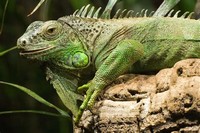Facts about Iguana

The green iguana ranges over a large geographic area, from southern Brazil and Paraguay to as far north as Mexico and the Caribbean Islands.

The iguana has also been used as a food source in Central and South America for the past 7000 years.

The Lesser Antillean iguana is found in scrub woodland, rainforest, and mangrove throughout the Lesser Antilles on Anguilla, St. Martin, St. Eustatius, Antigua, Guadeloupe, Dominica, and Martinique (Breuil and Day 1996).

Iguanidae is a family of lizards composed of iguanas and related species, including the green iguana commonly kept as a pet.

When swimming, an iguana remains submerged and lets its four legs hang limply against its side and propels itself through the water with powerful tail strokes (Swanson 1950).

The genus Iguana includes two species: The green iguana and the Lesser Antillean iguana.

During cold, wet weather, green iguanas prefer to stay on the ground for greater warmth (Swanson 1950).

The green iguana (Iguana iguana) is a large, arboreal herbivorous species of lizard of the genus iguana, native to Central and South America.

Their whip-like tails can be used to deliver painful strikes and, like many other lizards, the tail can break off when grabbed, allowing the iguana to escape.
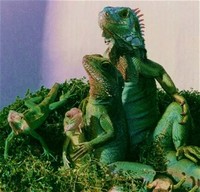
The iguana family, Iguanidae, also includes smaller species whose members are not called iguanas.
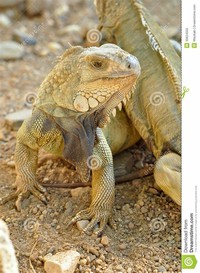
Green iguanas are diurnal and arboreal and often found near water (Cogger and Zweifel 1992; Samuelson 1995).

The Lesser Antillean iguana varies in color between different island populations, but the base color tends to be gray, with green splotching on the underside (Lazell 1973).

Green iguanas from the western region of Costa Rica are red and animals of the northern ranges, such as Mexico, appear orange (de Vosjoli and Blair 1992; Samuelson 1995).

Like the green iguana, Lesser Antillean iguanas are primarily herbivores.

Green iguanas possess a row of spines along their backs and along their tails that helps to protect them from predators (Samuelson 1995).

Juvenile green iguanas from El Salvador are often bright blue as babies; however they lose this color as they get older (De Vosjoli and Blair 1992).

The Lesser Antillean iguana (Iguana delicatissima) is another of two species of lizard of the genus Iguana.

Green iguanas from Guatemala and southern Mexico have small horns on their snouts between their eyes and their nostrils, whereas others do not (Samuelson 1995).

The feature that most easily distinguishes these two species is the large, round scale, which the green iguana has below each ear hole, but the Lesser Antillean iguana does not.

The Moche people of ancient Peru worshiped animals and often depicted Green iguanas in their art (Berrin and Larco Museum 1997).

The green iguana has been introduced to the Lesser Antilles as an invasive species and directly competes with the Lesser Antillean iguana for food and resources (Day et al.

Their whip-like tails can be used to deliver painful strikes and, like many other lizards, the tail can break off when grabbed, allowing the iguana to escape.
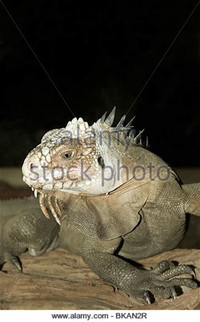
The Lesser Antillean iguana is a vulnerable species and is found on the IUCN Red List (Breuil and Day 1996).

Endemic to the Lesser Antilles, it is in severe decline due to habitat destruction, feral predators, hunting, and hybridization with its sister species, the green iguana.
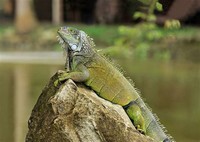
The green iguana grows to 1.5 meters in length from head to tail, although a few specimens have grown more than 2 meters (6 feet) and can weigh upwards of 20 pounds (10 kg).

Green iguanas have evolved a white photosensory organ on the top of their heads called the parietal eye, which are also called a third eye, pineal eye, or pineal gland (Brames 2007).

In Central and South America, green iguanas are used as a source of meat and are often referred to as gallina de palo, "bamboo chicken" or "chicken of the tree" (Swanson 1950).

The word "Iguana" is derived from a Spanish form of the original Taino name for the species, "Iwana" (Coles 2002).

On islands such as Bonaire, Curacao, Aruba, and Grenada, a green iguana's color may range from green to lavender, black, and even pink (de Vosjoli and Blair 1992; Samuelson 1995).

